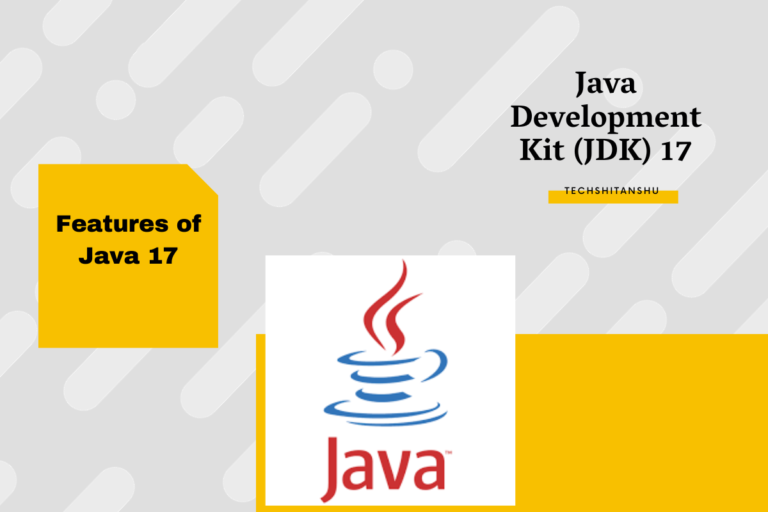The New Features Of Java 17 : Java Development Kit (JDK) 17
This blog describes some of the enhancements in Java SE 17 and JDK 17. Java 17 is a Long-Term Support (LTS) release and remains one of the most widely adopted versions in enterprises, especially for backend systems, microservices, and distributed applications.
This guide gives you a clean, modern, practical breakdown of all major Java 17 features — with real examples, use cases, and my personal experience using them in production systems.

1. Sealed Classes — Controlled Inheritance
Sealed classes allow you to restrict which classes can extend a parent class.
✅ Why It Matters
In large systems, too much inheritance creates unpredictable behavior.
Sealed classes give you safe, explicit hierarchies.
Example
public sealed class Payment permits UPI, CardPayment, Wallet {}
final class UPI extends Payment {}
sealed class CardPayment extends Payment permits CreditCard, DebitCard {}
non-sealed class Wallet extends Payment {}
2. Pattern Matching for instanceof
Java 17 simplifies type checks:
Before Java 17
if (obj instanceof String) {
String s = (String) obj;
System.out.println(s.toUpperCase());
}
With Pattern Matching
if (obj instanceof String s) {
System.out.println(s.toUpperCase());
}
💡 Cleaner, fewer casts, less boilerplate.
3. Enhanced Switch (Preview Feature)
(Java 17 continues improvements)
Why It’s Useful
More expressive
Can match types
Helps with sealed class hierarchies
switch (obj) {
case Integer i -> System.out.println("Int: " + i);
case String s -> System.out.println("String: " + s);
default -> System.out.println("Unknown");
}
4. Records — Immutable Data Carriers
Java 17 stabilizes records introduced in earlier versions.
Example
public record User(String name, int age) {}
Benefits
✔ Reduces boilerplate
✔ Perfect for DTOs in REST APIs
✔ Automatically provides toString(), equals(), hashCode()
5. New Random Number Generator (RNG) API
Java 17 adds a modern, pluggable PRNG architecture.
Example
var rng = RandomGenerator.of("L64X128MixRandom");
System.out.println(rng.nextInt());
Use Cases
Simulations
Gaming
Cryptographic-strength randomness
6. Removal of Deprecated Security Manager
The Security Manager is officially deprecated.
What This Means
Apps should move to modern sandboxing and container-based security.
Cloud-native apps are unaffected.
7. JDK Internals Strongly Encapsulated
Sun-internal APIs are now blocked.
Impact
If you previously used sun.misc.Unsafe, expect warnings or failure.
Use official APIs instead.
8. Improved Garbage Collection (ZGC & G1)
Java 17 continues major GC improvements:
Benefits
✔ Ultra-low pause times
✔ Better throughput
✔ Better memory management on large heaps
Personal Experience
My microservices handling high-traffic JSON workloads saw ~20–30% lower pauses with ZGC on Java 17.
9. Apple Silicon (M1/M2) Support
A huge benefit for developers using MacBooks.
✔ Faster builds
✔ Lower battery usage
✔ Better JVM performance
10. Enhanced Pseudo-Random Number Generators
Support for new algorithms:
LXM family
JumpableRandom
SplittableRandom improvements
ASCII Architecture Diagram How Java 17 Feature Improvements Fit Into a Modern App
+------------------------------+
| Application Layer |
| (Records + Sealed Classes) |
+---------------+--------------+
|
Pattern Matching Switch
|
+---------------+--------------+
| JVM Layer (GC, PRNG, JIT) |
+---------------+--------------+
|
OS & Hardware (M1/M2)
When Should You Upgrade to Java 17?
Upgrade if you want:
✔ Long-term support until 2029
✔ Better performance
✔ Modern syntax
✔ More secure defaults
✔ Cleaner APIs
Real-World Use Cases (From My Experience)
💼 1. Enterprise Microservices
Records reduce DTO clutter, sealed classes help define strong domain models.
📊 2. Event-Driven Systems
Pattern matching and sealed hierarchies simplify event-type handling.
🔐 3. Security-Sensitive Apps
Strong encapsulation reduces accidental dependency on unsafe internals.
🎮 4. High-volume CPU-heavy systems
New PRNG improves simulation performance.
Add java.time.InstantSource
A new interface java.time.InstantSource has been introduced. This interface is an abstraction from java.time.Clock that only focuses on the current instant and does not refer to the time zone.
Hex Formatting and Parsing Utility
java.util.HexFormat provides conversions to and from hexadecimal for primitive types and byte arrays. The options for delimiter, prefix, suffix, and uppercase or lowercase are provided by factory methods returning HexFormat instances.
“Related Packages” on a Package Summary Page
The summary page for a package now includes a section listing any “related packages”. The set of related packages is determined heuristically on common naming conventions, and may include the following:
- The “parent” package (that is, the package for which a package is a subpackage)
- Sibling packages (that is, other packages with the same parent package)
- Any subpackages
The related packages need not all be in the same module.
Frequently Asked Questions (FAQ)
1. Is Java 17 stable for production?
➡ Yes. It’s an LTS version and widely adopted by enterprises.
2. Will Java 17 break my existing apps?
➡ Mostly no — unless you used internal APIs like sun.misc.
3. Are sealed classes mandatory?
➡ No, they are optional — but great for domain modeling.
4. Do I need to rewrite my DTOs as records?
➡ No, but it can improve readability and reduce boilerplate.
5. Is upgrading from Java 11 worth it?
➡ 100%. Java 17 provides big performance and syntax improvements.
6. Does Java 17 require new IDE versions?
➡ Yes, upgrade IntelliJ/Eclipse to latest versions for full feature support.
7. Are Switch Expressions final?
➡ Pattern matching for switch is still preview; simple expressions are stable.
8. Does Java 17 improve GC?
➡ Yes, especially ZGC and G1.
9. Is Java 17 faster than Java 8?
➡ Yes — in most real workloads, 20–40% faster.
10. Should students learn Java 17 first?
➡ Absolutely. It represents modern Java.


Leave a Reply